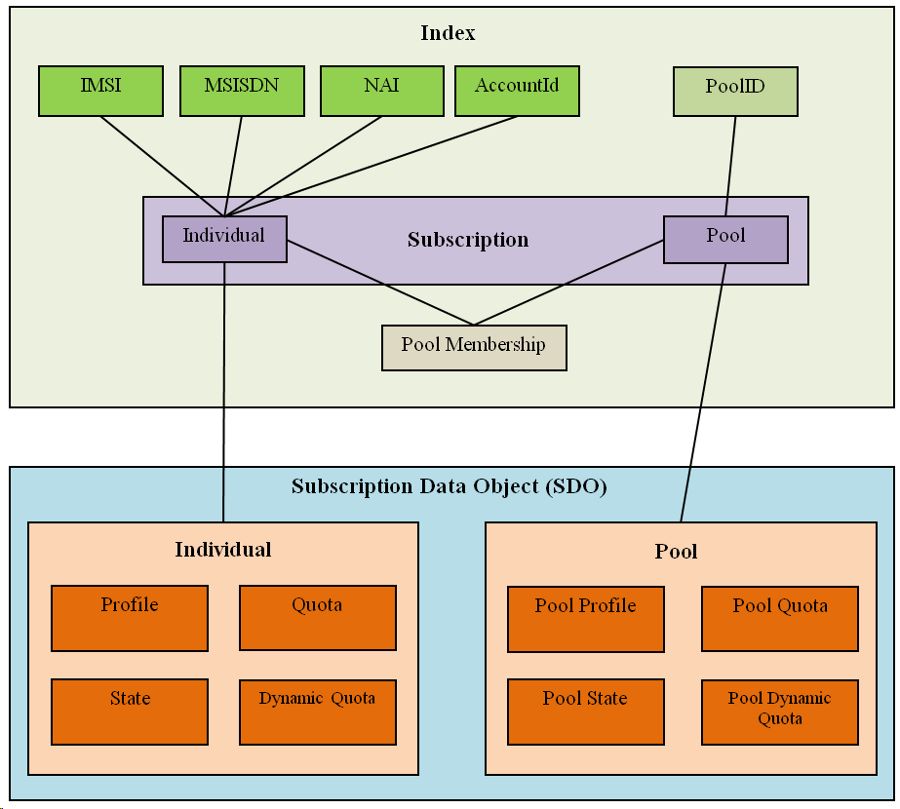The User Data Repository is a system used for the storage and management of subscriber policy control data. The User Data Repository functions as a centralized repository of subscriber data for the PCRF.
Subscriber-related data includes:
- Profile/Subscriber Data: pre-provisioned information that describes the capabilities of each subscriber. This data is typically written by the your OSS system (via a provisioning interface) and referenced by the PCRF (via the Sh interface).
- Quota: information that represents the subscriber's use of managed resources quota, pass, top-up, roll-over). Although the User Data Repository provisioning interfaces allow quota data to be manipulated, this data is typically written by the PCRF and only referenced using the provisioning interfaces.
- State: subscriber-specific properties. Like quota, this data is typically written by the PCRF, and referenced using the provisioning interfaces.
- Dynamic Quota: dynamically configured information related to managed resources (pass, top-up, roll-over). This data may be created or updated by either the provisioning interface or the Sh interface.
- Pool Membership: The pool to which the subscriber is associated. The current implementation allows a subscriber to be associated with a single pool, although the intention is to extend this to multiple pools in the future.
The User Data Repository can also be used to group subscribers using Pools. This feature allows wireless carriers to offer pooled or family plans that allow multiple subscriber devices with different subscriber account IDs, such as MSISDN, IMSI, or NAI to share one quota.
Pool-related data includes:
- Pool Profile: pre-provisioned information that describes a pool
- Pool Quota: information that represents the pool's use of managed resources (quota, pass, top-up, roll-over)
- Pool State: pool-specific properties
- Pool Dynamic Quota: dynamically configured information related to managed resources (pass, top-up, roll-over)
- Pool Membership: list of subscribers that are associated with a pool
The data architecture supports multiple Network Applications. This flexibility is achieved though implementation of a number of registers in a Subscriber Data Object (SDO) and storing the content as Binary Large Objects (BLOB). An SDO exists for each individual subscriber, and an SDO exists for each pool.
The Index contains information on the following:
- Subscription:
- A subscription exists for every individual subscriber, and for every pool
- Maps a subscription to the user identities through which it can be accessed
- Maps an individual subscription to the pool of which they are a member
- Pool Subscription:
- A pool subscription exists for every pool
- Maps a pool subscription to the pool identity through which it can be accessed
- Maps a pool subscription to the individual subscriptions of the subscribers that are members of the pool
- User Identities:
- Use to map a specific user identity to a subscription
- IMSI, MSISDN, NAI and AccountId map to an individual subscription
- PoolID maps to a pool subscription
- Pool membership
- Maps a pool to the list of the individual subscriber members
- The Subscription Data Object (SDO):
- An SDO record contains a list of registers, holding a different type of entity data in each register.
- An SDO record exists for:
- Each individual subscriber
- Defined entities stored in the registers are:
- Profile
- Quota
- State
- Dynamic Quota
- Each pool
- Defined entities stored in the registers are:
- Pool Profile
- Pool Quota
- Pool State
- Pool Dynamic Quota
Provisioning applications can create, retrieve, modify, and delete subscriber/pool data. The indexing system allows to access Subscriber SDO via IMSI, MSISDN, NAI, or AccountId. The pool SDO can be accessed via PoolD.
A field within an entity can be defined as mandatory, or optional. A mandatory field must exist and cannot be deleted.
A field within an entity can have a default value. If an entity is created, and the field is not specified, it will be created with the default value.
A field within an entity can be defined so that once created, it cannot be modified. Any attempt to update the field once created will fail.
A field within an entity can have a reset value. If a reset command is used on the entity, those fields with a defined reset value will be set to the defined value. This is currently applicable only to field values within a row for the Quota entity.
Note:
This section describes the default
User Data Repository data model as defined in the Subscriber Entity Configuration (SEC). The data model can be customized via the UDR GUI.


